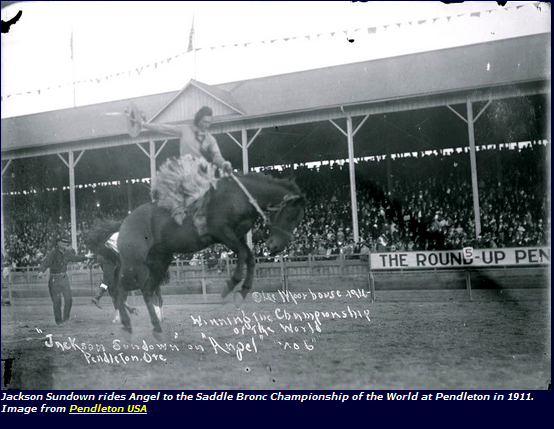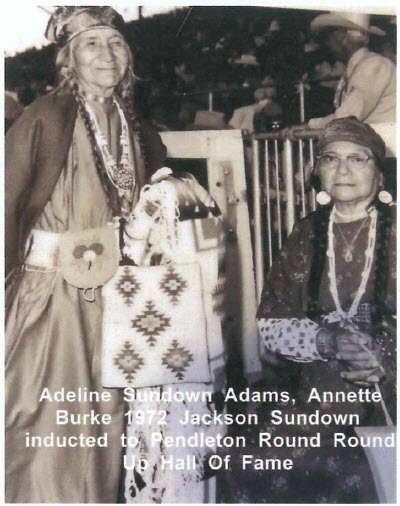Jackson Sundown

Waaya-Tonah-Toesits-Kahn, Earth Left by the Setting Sun
Jackson Sundown (1863-December 18, 1923), born Waaya-Tonah-Toesits-Kahn (meaning Earth Left by the Setting Sun or Blanket of Sun), was a member of the Wallowa Band of Nez Perce Indians and Chief Joseph’s nephew.
Horses played an important role to the Nez Perce people. They used them to hunt buffalo, and to the tribe, the horse was a warrior. From an early age, Jackson Sundown worked and cared for horses. When Jackson Sundown was 14 years old, the U.S. Cavalry’s “war against the Native Americans” was underway. Chief Joseph and about 800 tribal members decided to try and reach Canada to meet up with Sitting Bull and his tribe in order escape capture from the Calvary. During this trek, Jackson Sundown and Suhm-Keen (Sam Tilden) were assigned to attend to the horses in the evening and herd the horses while the tribe decamped. Jackson Sundown was among Piyoopiyoo Xayxaya (Chief White Bird) and nearly 300 tribal members that made it to Canada. The others were captured and were sent to an encampment.
It is said that two years after the war began, Jackson Sundown returned to the United States. It is also said that he lived with a family on the Flathead Reservation, then moved to Washington, back to Montana.
Jackson made his living by breeding, raising, breaking in and selling horses. He began entering rodeos and was very great at it. In 1911, at the age of 48, Jackson made it into the Saddle Bronc Finals for the World Championship at the Pendleton Round Up. Jackson did so well in the rodeos he competed in that contestants would withdrawal once they heard Jackson would be competing because they knew Jackson would win. This became an issue and the managers of the rodeos came up with hiring Jackson as an exhibition rider to entertain the crowd.
“In 1916, he was the first full blood Indian to win the Bronco Bucking Championship of the World. He was 50 years old and wearing his hair in traditional pompadour and braid style with a traditional high crown “Indian Hat” and wearing bright orange “woolies” (chaps) with large black spots. He rode his bronc, Angel, to become one of America’s greatest bronc busters. Amid chaps, shouts, whistles, and thunderous stomping applause the crowd cheered, “Ride’em Sundown!” When the ride was over, the cowboys rushed up to Sundown and grasped his hand, and he tossed his hat in the air with joy. He was given a horse with a beautiful handmade saddle and circled the quarter-mile track as the crowd shouted, waved their hats and hands and cheered wildly.” (Wehr, 1976)


Jackson Sundown was one of the people featured in the Idaho State Historical Society’s “Essential Idaho” exhibit for the Territorial Sesquicentennial. His stunning performance at the Pendleton Round Up in Pendleton, Oregon was the subject of Ken Kesey’s popular novel, The Last Go ‘Round.
Jackson Sundown was inducted into the American Indian Athletic Hall of Fame, the National Multicultural Western Heritage Museum and Hall of Fame, and the National Cowboy and Western Museum and Hall of Fame.

In 1923, Jackson Sundown died of pneumonia. He was buried at Slickpoo Mission Cemetery near Jacques Spur. Later, a stone monument was placed there to remember the Nez Perce warrior and horseman, Waaya-Tonah-Toesits-Kahn. At the time of his death, the US Government did not consider Native Americans to be American Citizens.
Jackson Sundown Inducted in the Idaho Hall of Fame
Legendary rodeo star Jackson Sundown is a 2014 inductee into Idaho’s Hall of Fame. To commemorate the event, the Nez Perce Tribe hosted a reception and exhibit at the Clearwater River Casino and Hotel outside of Lewiston, Idaho. The event was held on July 18 and the public was invited to the free event.
Jackson Sundown was one of the people featured in the Idaho State Historical Society’s “Essential Idaho” exhibit for the Territorial Sesquicentennial. Born in 1863, he tended the horse herd during the Nez Perce Flight of 1877, and was among Chief White Bird and the tribal members who escaped to Canada. He later returned to Idaho and made his living by breeding and selling horses. Sundown also became one of the world’s most accomplished rodeo riders. In 1916, at the age of 53, a man twice the age of many of his competitors, Sundown earned the title “World Champion Bronco Rider.” His stunning performance at the Pendleton Round Up in Pendleton, Oregon, that year, was the subject of Ken Kesey’s popular novel, The Last Go “Round.” Also, it was known that Jackson Sundown beaded his own gloves that he wore. In the corner of his gloves, he beaded the initials JS.

The photograph is of Annette Burke and Adeline Sundown Adams during the ceremony of inducting Jackson Sundown, Adeline’s father, into the Pendleton Round Up Hall of Fame in 1972. The Round Up committee discovered that Adeline was the daughter of Jackson Sundown and this is the picture with her in front of the main Round Up Grandstand. Adeline did not speak English but spoke Nez Perce, Yakama, Slaish, Crow, and Lakota. Adeline spoke to the crowd and Annette interpreted what she said. It is reported by family member that all the people in the Grandstand stood up for her and Annette when they went around in the horse and buggy carriage. Adeline faithfully attended the Round Up every year. She lived in Ronan, MT.
Jackson Sundown is buried near Jacques Spur, Idaho, where he lived near the creek at Jacques Spur.
By Sandi McFarland, Administrator, NPNHT
Back of the US Forest Service Post Card
Wiyetenetuucickan (1863-1923) Jackson Sundown
Tending the horse herd during the 1877 war and flight of the Nez Perce (Niimiipuu), Sundown was among nearly 300 tribal members, led by Piyoopiyoo Xayxaya (Chief White Bird), who escaped to Canada. Returning later to Idaho, he made his living by breeding and selling horses. In 1916, at the age of 53, Sundown earned the title, “World Champion Bronco Rider.” His stunning performance at the Pendleton, Oregon Round Up that year was the subject of Ken Kesey’s popular novel, The Last Go ‘Round.
Front Photo: Jackson Sundown, 1918.
Photo courtesy Nez Perce National Historic Park, NEPE-HI-0022.
For more information about the Nez Perce (Niimiipuu) and the Nez Perce (Nee-Me-Poo) National Historic Trail, visit www.fs.fed.gov/npnht
The USDA is an equal opportunity provider, employer, and lender.

